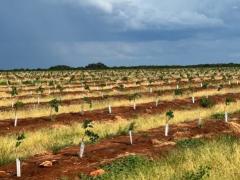The next quarter century also holds excellent prospects for the SA coal industry, writes Alan Peat SPOORNET AND its coal exporting partners celebrated the 25th anniversary of the high-performing COALlink line between the inland coalfields and the export terminal at Richards Bay in style at the weekend. The line recorded its billionth ton in exports in December last year, and exported a record-setting 66.8-million tons in the financial year ending March 31. The next quarter century also holds excellent prospects for the SA coal industry and the COALlink dedicated line, according to Spoornet c.e.o. Zandile Jakavula. ÒThe demand for seaborne traded steam coal was 320-million tons in 2000,Ó he told FTW. ÒResearch by the local industry estimates that this will grow at least 2.5% annually until 2020.Ó Jakavula expects that the SA coal exporters will achieve the same percentage growth rate (1.65 to 2-mt a year in volume terms) - up to a level of 82-mt a year. That will require a further increase in coal line and export terminal capacity. The immediate forecast for 2001 is an export total of 69-mt of steam coal, and 2-mt of metallurgical coal. The future of the SA coal export industry, according to Jakavula, is driven by a number of factors. Our current market share in steam coal exports, he added, is about 20%. ÒHowever SAÕs market share in the longer term is expected to fall to about 17%.Ó But, at the same time, this will be a smaller portion of a larger pie. ÒThe world population,Ó said Jakavula, Òis expected to increase to 12-billion by the year 2050. ÒBetween 1998 and 2030, total world electricity demand is expected to double - from 12-trillion kilowatt hours per annum to 23-trillion. ÒCoal accounts for 27% of the worldÕs primary energy consumption - and for a 36% share of the worldÕs generation of electricity. ÒWorld coal consumption, therefore, is set to increase from 5.1-billion tons presently, to 8.6-bn by 2030.Ó At the same time, coal has lost share to oil and petroleum products, gas, nuclear and renewable energy. Jakavula expects this trend to continue. ÒHowever,Ó he told FTW, ÒcoalÕs market share in primary energy is expected, according to Barlow Jonker, to still be around 25% by 2030.Ó












